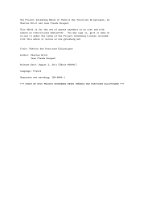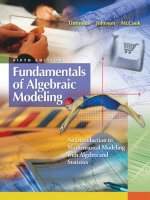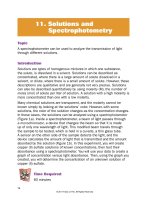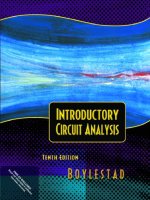Ebook Chemistry of the textile industry Part 1
Bạn đang xem bản rút gọn của tài liệu. Xem và tải ngay bản đầy đủ của tài liệu tại đây (7.1 MB, 188 trang )
Contents
Preface ............................................................................
v
Contributors .....................................................................
vii
1.
Introduction: the Structure of Fibres ...................
1
1.1
Introduction ...........................................................
1
1.2
Classification of Textile Fibres ..............................
2
1.2.1
Natural Fibres ........................................
2
1.2.2
Man-made Fibres: Regenerated
Cellulose and Its Derivatives ..................
9
1.2.3
Synthetic Polymer Fibres .......................
10
1.2.4
Other Types of Fibre ..............................
15
The Problem of Fibre Structure ............................
15
1.3
1.3.1
Approaches to Describing Fibre Fine
Structure ................................................
15
Comments on Fibre Macrostructure ......
34
Relationship of Structure to Tensile Properties ....
36
1.3.2
1.4
1.4.1
General Influence of Structural
Features .................................................
36
Examples ...............................................
39
Acknowledgement ...........................................................
43
References ......................................................................
43
1.4.2
This page has been reformatted by Knovel to provide easier navigation.
ix
x
2.
Contents
The Whitening of Textiles .....................................
46
2.1
Introduction ...........................................................
46
2.2
Natural and Synthetic Fibers ................................
47
2.2.1
Cellulosics ..............................................
48
2.2.2
Natural Polyamides ................................
50
2.2.3
Synthetics ..............................................
53
2.2.4
Bleaching of Fiber Blends ......................
54
Bleaching Agents ..................................................
54
2.3.1
Chlorine-containing Oxidants .................
56
2.3.2
Inorganic Peroxygen Bleaches ..............
57
2.3.3
Organic Peroxygen Bleaches ................
58
2.3.4
Reducing Bleaches ................................
59
2.3.5
Photosensitizing Bleaches .....................
61
2.3.6
Fluorescent Whitening Agents ...............
62
Energy and the Environment ................................
64
Survey of Bleaching Protocols ........................................
67
References ......................................................................
97
2.3
2.4
3.
Fire-retardant Textiles ........................................... 102
3.1
The Problem ......................................................... 102
3.1.1
The Risk ................................................. 102
3.2
The Combustion Process ..................................... 103
3.3
Developing a Fire-retarding Solution .................... 103
3.3.1
3.4
3.5
Terminology and Standards ................... 104
Flammability of Materials ...................................... 106
3.4.1
Limiting Oxygen Index ........................... 106
3.4.2
Insulation and Retardancy ..................... 106
Which Materials Are Best? ................................... 107
3.5.1
Wool as a Low-flammability Material ..... 107
This page has been reformatted by Knovel to provide easier navigation.
Contents
3.6
3.7
3.8
xi
3.5.2
Flammability of Polypropylene ............... 108
3.5.3
Flammability of Cellulosic Materials ....... 108
3.5.4
Thermoplastic Fibres as Lowflammability Materials ............................ 108
3.5.5
Testing Flammability .............................. 108
3.5.6
Durability ................................................ 109
3.5.7
Tests for Furniture .................................. 109
3.5.8
Barrier-layer Fire-retardant Structures ... 110
The Chemistry of Fire-retardant Finishing ............ 110
3.6.1
Exclusion of Oxygen .............................. 110
3.6.2
Modification of the Pyrolysis Route ........ 110
3.6.3
The Role of Lewis Acids in Promoting
Dehydration ............................................ 112
3.6.4
Vapour-phase Fire-retardant Action ....... 113
3.6.5
Metal Oxides and Salts as Flame
Retardants ............................................. 114
3.6.6
Synergistic Flame-retardant Effects ....... 114
Commercial Solutions for Fire Retardancy ........... 114
3.7.1
Design .................................................... 114
3.7.2
Intrinsically Fire-retardant Materials ....... 115
3.7.3
Commercial Fire-retardant Treatments
for Cotton ............................................... 116
3.7.4
Finishes for Wool ................................... 120
3.7.5
Finishes for Polyester/Cotton ................. 121
Premature Failure of Flame Retardancy ............... 122
3.8.1
Ion-exchange Effects in Hard Water ...... 122
3.8.2
Sensitivity to Chlorine-containing
Bleaches ................................................ 122
3.8.3
Detergent and Softener Effects .............. 122
This page has been reformatted by Knovel to provide easier navigation.
xii
Contents
3.8.4
3.9
Steam Sterilization ................................. 123
The Cost of Fire-retardant Solutions ..................... 123
References ...................................................................... 124
4.
Physical and Chemical Effects of Domestic
Laundering Processes .......................................... 125
4.1
Introduction ........................................................... 125
4.2
Domestic Laundry Processes – Effects of Water,
Mechanical Action and Tumble Drying ................. 127
4.3
4.4
4.2.1
Introduction ............................................ 127
4.2.2
Physical Effects of Water, Temperature
and Mechanical Action on Textile
Fibres ..................................................... 128
4.2.3
Physical Effects of Washing on Fibres
and Fabrics ............................................ 131
Chemical Effects of Fabric Washing Product
Ingredients on Textile Fibres ................................ 145
4.3.1
Water Softeners or ‘Builders’ ................. 145
4.3.2
Alkalinity ................................................. 148
4.3.3
Anionic, Nonionic and Cationic
Surfactants ............................................. 150
4.3.4
Bleaching Systems ................................ 152
4.3.5
Enzymes and Their Effects on Textile
Fibres ..................................................... 157
4.3.6
Other Ingredients ................................... 161
Effects of Wash Process and Product
Formulation Variables on Dyed Fabrics ................ 165
4.4.1
Introduction ............................................ 165
4.4.2
Effects of Bleaching Systems ................ 165
4.4.3
Dye Desorption and Cross-staining ....... 166
This page has been reformatted by Knovel to provide easier navigation.
Contents
xiii
Acknowledgement ........................................................... 171
References ...................................................................... 171
5.
Easy Care ............................................................... 173
5.1
Introduction ........................................................... 173
5.2
Urea-formaldehyde Resins ................................... 175
5.3
Methylated Urea-formaldehyde Resins ................ 175
5.4
Melamine Resins .................................................. 177
5.5
Mechanical Finishing ............................................ 177
5.6
The Problem of Fishy Odour in Resin-treated
Fabrics .................................................................. 178
5.7
Reactant-type Products ........................................ 180
5.8
Formulations for Use of Propylene Ureaformaldehyde Resin .............................................. 182
5.9
Solids of Resins .................................................... 184
Registered Trademarks .................................................. 186
References ...................................................................... 186
6.
Machine-washable Knitwear – Production
Routes .................................................................... 187
6.1
Introduction ........................................................... 187
6.2
Garment Treatments ............................................. 189
6.2.1
Equipment .............................................. 189
6.2.2
Scouring and Milling Procedures for
Woolen Spun Knitwear .......................... 191
6.2.3
Scouring and Anti-cockle Procedures
for Worsted Spun Knitwear .................... 192
6.2.4
Garment Shrink-resist Treatments for
Knitwear ................................................. 196
6.2.5
Polymer-only Treatments ....................... 201
This page has been reformatted by Knovel to provide easier navigation.
xiv
Contents
6.3
Yarn Treatments ................................................... 202
6.4
Continuous Treatments ........................................ 203
6.5
Environmental Considerations .............................. 206
6.6
Conclusion ............................................................ 208
Shrink-resist Polymer Compositions ............................... 208
References ...................................................................... 209
7.
Coated and Laminated Fabrics ............................ 210
7.1
7.2
7.3
7.4
7.5
Introduction ........................................................... 210
7.1.1
History .................................................... 210
7.1.2
General Usage ....................................... 211
Textile Substrates ................................................. 211
7.2.1
Synthetic Continuous Filament
Fabrics ................................................... 211
7.2.2
Staple Fibre Fabrics ............................... 212
7.2.3
Special Substrates ................................. 212
Techniques for Coating Fabrics ............................ 213
7.3.1
Basic Techniques ................................... 213
7.3.2
Application Systems ............................... 213
7.3.3
Control Parameters in Coating ............... 215
Chemistry of Coating Polymers ............................ 217
7.4.1
Polyurethanes ........................................ 217
7.4.2
Preparation of Polyurethanes ................ 217
7.4.3
Production of Complex Polymers ........... 218
7.4.4
Isocyanates ............................................ 218
7.4.5
Coating Formulations ............................. 219
7.4.6
Polyurethane Properties ........................ 221
Natural and Synthetic Rubbers ............................. 221
7.5.1
Natural Rubber ....................................... 222
This page has been reformatted by Knovel to provide easier navigation.
Contents
7.6
7.7
xv
7.5.2
Polychloroprene Rubbers (Neoprene) ... 224
7.5.3
Polyisobutylene Rubbers (Butyl) ............ 225
7.5.4
Styrene-butadiene Rubbers (SBR) ........ 225
7.5.5
Nitrile Rubbers ....................................... 227
Coating Polymers and Elastomers ....................... 228
7.6.1
Poly(Vinyl Chloride) (PVC) ..................... 228
7.6.2
Polyacrylate Elastomers ........................ 229
7.6.3
Silicone Elastomers ............................... 231
7.6.4
Poly(Tetrafluoroethylene) (PTFE) .......... 232
7.6.5
Polyethylene .......................................... 232
7.6.6
Chlorinated and Chlorosulphonated
Polyethylenes ......................................... 234
Liquid Proof/Vapour Permeable Coated Fabrics .. 234
7.7.1
Physiological Aspects ............................ 235
7.7.2
Types of Waterproof/Vapour
Permeable Fabrics ................................. 236
7.7.3
Microporous Coatings and Films
(Poromerics) .......................................... 237
7.7.4
Hydrophilic Coatings and Films ............. 240
7.7.5
Relative Performance of Breathable
Barrier Fabrics ....................................... 243
7.8
Test Methods for Coated and Laminated
Fabrics .................................................................. 243
7.9
End-use Applications for Rubber-coated
Fabrics .................................................................. 243
7.10 End-use Applications for Polymer-coated
Fabrics .................................................................. 246
7.11 Summary .............................................................. 246
References ...................................................................... 247
This page has been reformatted by Knovel to provide easier navigation.
xvi
8.
Contents
Scouring, Enzymes and Softeners ...................... 249
8.1
Introduction ........................................................... 249
8.2
Aqueous Scouring Processes ............................... 250
8.3
8.4
8.5
8.2.1
The Surfactant Molecule ........................ 251
8.2.2
The Nature of Surface Activity ............... 253
8.2.3
Critical Micelle Concentration (CMC) ..... 256
8.2.4
Scouring of Textile Substrates ............... 257
8.2.5
Choosing the Surfactant for a Fibre
Type ....................................................... 259
Enzymes ............................................................... 260
8.3.1
Introduction ............................................ 260
8.3.2
Enzymes in Textile Processing .............. 262
8.3.3
Desizing of Cotton .................................. 262
8.3.4
Biopolishing and Stonewashing of
Cotton .................................................... 263
8.3.5
Wool Processing .................................... 266
Softeners .............................................................. 267
8.4.1
Introduction ............................................ 267
8.4.2
Softener Types ....................................... 269
8.4.3
Mechanical Measurement of Fabric
Properties ............................................... 273
Mercerisation ........................................................ 275
References and Bibliography .......................................... 275
9.
The Colouring of Textiles ..................................... 276
9.1
The Development of a Scientific Approach ........... 276
9.2
The Physical Chemistry of Coloration ................... 286
9.2.1
Binding Forces ....................................... 287
9.2.2
Dyeing Equilibria and Kinetics ............... 291
This page has been reformatted by Knovel to provide easier navigation.
Contents
9.3
9.4
xvii
Classes of Colorants and Their Applications ........ 299
9.3.1
Acid Dyes ............................................... 300
9.3.2
Direct Cotton Dyes ................................. 304
9.3.3
Basic Dyes ............................................. 307
9.3.4
Reactive Dyes ........................................ 308
9.3.5
Disperse Dyes ........................................ 317
9.3.6
Vat Dyes ................................................ 320
9.3.7
Sulphur Dyes ......................................... 323
9.3.8
Azoic Dyes ............................................. 325
9.3.9
Pigments ................................................ 326
Textile Printing ...................................................... 328
References ...................................................................... 331
General Bibliography ...................................................... 332
10. The Environmental Impact of the Textiles
Industry .................................................................. 333
10.1 Introduction ........................................................... 333
10.2 The Environment .................................................. 333
10.2.1
The Immediate Environment .................. 334
10.2.2
The Local Environment .......................... 335
10.2.3
The Regional Environment .................... 335
10.2.4
The Global Environment ........................ 335
10.2.5
The Gaia Hypothesis ............................. 336
10.2.6
Environmental Complexity ..................... 337
10.3 Environmental Impacts of the Textiles Industry .... 337
10.3.1
Resources .............................................. 337
10.3.2
Production of Waste ............................... 339
10.3.3
Air Pollution ............................................ 345
This page has been reformatted by Knovel to provide easier navigation.
xviii
Contents
10.4 Approaching the Problem ..................................... 347
10.4.1
Environmental Audits ............................. 347
10.4.2
Life-cycle Analysis ................................. 348
10.4.3
The Action Programme .......................... 350
10.4.4
Action Areas ........................................... 351
10.5 Conclusion – the Way Forward ............................. 353
References ...................................................................... 354
Index ............................................................................... 355
This page has been reformatted by Knovel to provide easier navigation.









